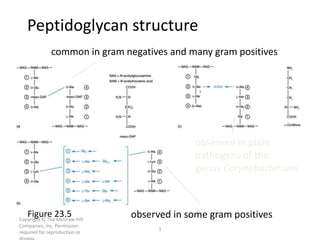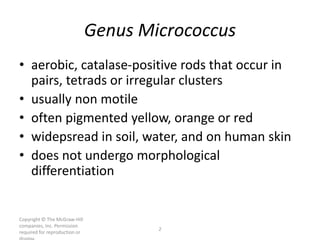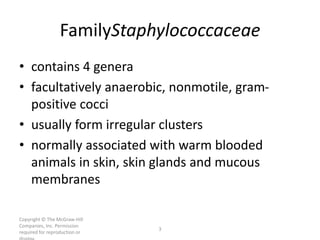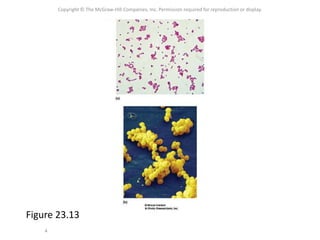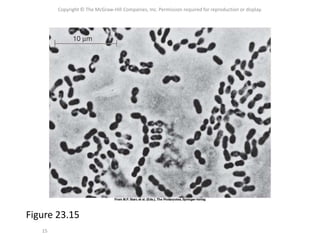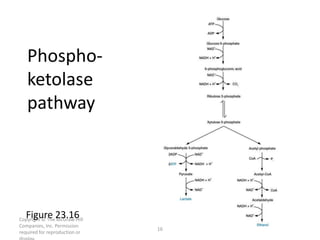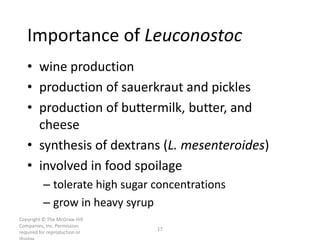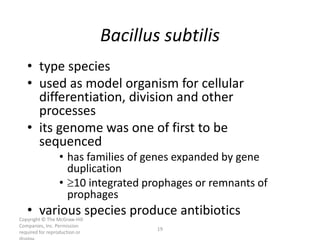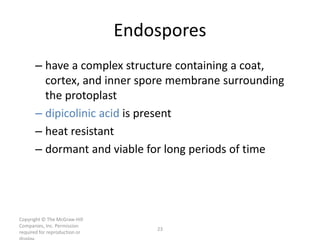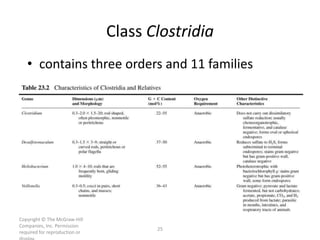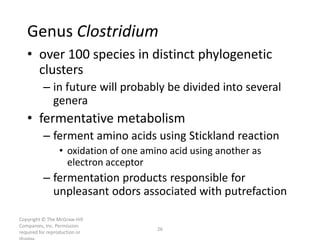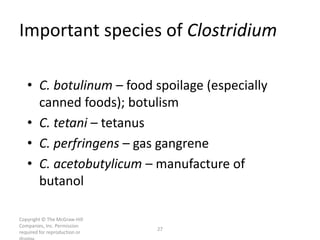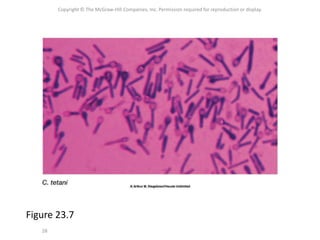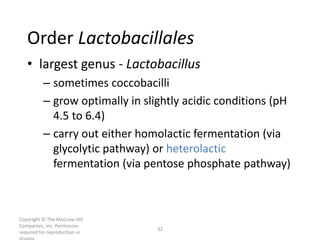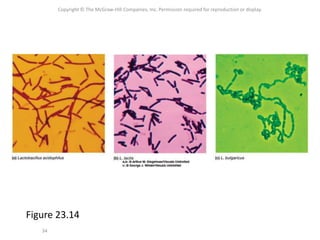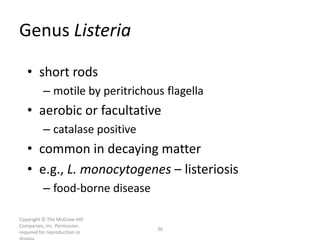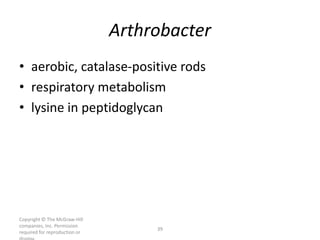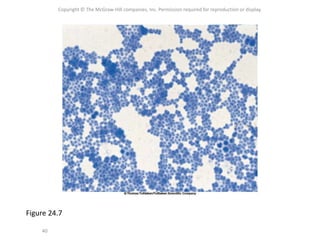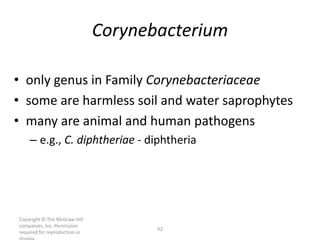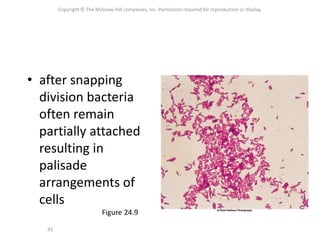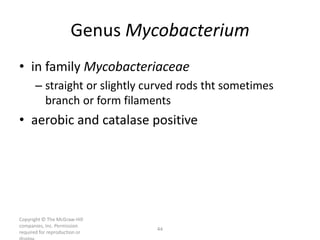Gram_positive___Ch 21.ppt
- 1. Copyright © The McGraw-Hill Companies, Inc. Permission required for reproduction or 1 Figure 23.5 common in gram negatives and many gram positives observed in some gram positives observed in plant pathogens of the genus Corynebacterium Peptidoglycan structure
- 2. Copyright © The McGraw-Hill companies, Inc. Permission required for reproduction or 2 Genus Micrococcus • aerobic, catalase-positive rods that occur in pairs, tetrads or irregular clusters • usually non motile • often pigmented yellow, orange or red • widepsread in soil, water, and on human skin • does not undergo morphological differentiation
- 3. Copyright © The McGraw-Hill Companies, Inc. Permission required for reproduction or 3 FamilyStaphylococcaceae • contains 4 genera • facultatively anaerobic, nonmotile, gram- positive cocci • usually form irregular clusters • normally associated with warm blooded animals in skin, skin glands and mucous membranes
- 4. Copyright © The McGraw-Hill Companies, Inc. Permission required for reproduction or display. 4 Figure 23.13
- 5. Copyright © The McGraw-Hill Companies, Inc. Permission required for reproduction or 5 Pathogenic Staphylococcus • Staphylococcus epidermidis – common skin resident – sometimes responsible for endocarditis and for infections of patients with lowered resistance • e.g., wound infections, surgical infections, and urinary tract infections
- 6. Copyright © The McGraw-Hill Companies, Inc. Permission required for reproduction or 6 Antibiotic Resistant Staphylococci • resistance to methicillin – Methicillin-Resistant Staphylococcus aureus (MRSA) • obtained from genetic elements received from other organisms • resistance to vancomycin, the “drug of last resort”
- 7. Copyright © The McGraw-Hill Companies, Inc. Permission required for reproduction or 7 Staphylococcus aureus • produces the virulence factor coagulase – causes blood plasma to clot • produces a-hemolysin – toxin which lyses cells • major cause of food poisoning – recently >1,000 school children in Texas had staphylococcal food poisoning caused by eating improperly handled chicken • found on nasal membranes and skin, and in gastrointestinal and urinary tracts
- 8. Copyright © The McGraw-Hill Companies, Inc. Permission required for reproduction or 8 nonmotile facultative and strict anaerobes homolactic fermentation Lancefield grouping system – based on polysaccharide and techoic acid antigens in cell wall or between cell wall and plasma membrane Streptococci
- 9. Copyright © The McGraw-Hill Companies, Inc. Permission required for reproduction or 9 a-hemolysis – incomplete lysis of red blood cells – seen as greenish zone around colony on blood agar b-hemolysis – complete lysis of red blood cells – seen as clear zone around colony on blood agar Table 23.5
- 10. Copyright © The McGraw-Hill Companies, Inc. Permission required for reproduction or display. 10 Figure 23.17
- 11. Copyright © The McGraw-Hill Companies, Inc. Permission required for reproduction or 11 Enterococci and lactococci
- 12. Copyright © The McGraw-Hill Companies, Inc. Permission required for reproduction or 12 Figure 23.18
- 13. Copyright © The McGraw-Hill Companies, Inc. Permission required for reproduction or 13 Important streptococci, enterococci, and lactococci • Streptococcus pyogenes – streptococcal sore throat, acute glomerulonephritis, and rheumatic fever • Streptococcus pneumoniae – lobar pneumonia and otitis media • Streptococcus mutans – dental caries • Enterococcus faecalis – opportunistic pathogen (urinary tract infections and endocarditis) • Lactococcus lactis – production of buttermilk and cheese
- 14. Copyright © The McGraw-Hill Companies, Inc. Permission required for reproduction or 14 Family Leuconostocaceae Genus Leuconostoc • facultative, gram-positive cocci • carry out heterolactic fermentation via phosphoketolase pathway • carry out heterolactic fermentation using phosphoketolase pathway • isolated from plants, silage and milk • play a role in food spoilage
- 15. Copyright © The McGraw-Hill Companies, Inc. Permission required for reproduction or display. 15 Figure 23.15
- 16. Copyright © The McGraw-Hill Companies, Inc. Permission required for reproduction or 16 Phospho- ketolase pathway Figure 23.16
- 17. Copyright © The McGraw-Hill Companies, Inc. Permission required for reproduction or 17 Importance of Leuconostoc • wine production • production of sauerkraut and pickles • production of buttermilk, butter, and cheese • synthesis of dextrans (L. mesenteroides) • involved in food spoilage – tolerate high sugar concentrations – grow in heavy syrup
- 18. Copyright © The McGraw-Hill Companies, Inc. Permission required for reproduction or display. 18 Class Bacilli • large variety of gram-positive organisms • contains two orders, Bacillales and Lactobacillales , 17 families and over 70 genera
- 19. Copyright © The McGraw-Hill Companies, Inc. Permission required for reproduction or 19 Bacillus subtilis • type species • used as model organism for cellular differentiation, division and other processes • its genome was one of first to be sequenced • has families of genes expanded by gene duplication • 10 integrated prophages or remnants of prophages • various species produce antibiotics
- 20. Copyright © The McGraw-Hill Companies, Inc. Permission required for reproduction or 20 Other important species of Bacillus • B. cereus – food poisoning • B. anthracis – anthrax • B. thuringiensis and B. sphaericus – used as insecticide – parasporal body – solid protein crystal that contains toxin
- 21. Copyright © The McGraw-Hill Companies, Inc. Permission required for reproduction or display. 21 Figure 23.9
- 22. Copyright © The McGraw-Hill Companies, Inc. Permission required for reproduction or 22 parasporal body endospore Figure 23.10 (a)
- 23. Copyright © The McGraw-Hill Companies, Inc. Permission required for reproduction or 23 Endospores – have a complex structure containing a coat, cortex, and inner spore membrane surrounding the protoplast – dipicolinic acid is present – heat resistant – dormant and viable for long periods of time
- 24. Copyright © The McGraw-Hill Companies, Inc. Permission required for reproduction or display. 24 Figure 23.6
- 25. Copyright © The McGraw-Hill Companies, Inc. Permission required for reproduction or 25 Class Clostridia • contains three orders and 11 families
- 26. Copyright © The McGraw-Hill Companies, Inc. Permission required for reproduction or 26 Genus Clostridium • over 100 species in distinct phylogenetic clusters – in future will probably be divided into several genera • fermentative metabolism – ferment amino acids using Stickland reaction • oxidation of one amino acid using another as electron acceptor – fermentation products responsible for unpleasant odors associated with putrefaction
- 27. Copyright © The McGraw-Hill Companies, Inc. Permission required for reproduction or 27 Important species of Clostridium • C. botulinum – food spoilage (especially canned foods); botulism • C. tetani – tetanus • C. perfringens – gas gangrene • C. acetobutylicum – manufacture of butanol
- 28. Copyright © The McGraw-Hill Companies, Inc. Permission required for reproduction or display. 28 Figure 23.7
- 29. Copyright © The McGraw-Hill Companies, Inc. Permission required for reproduction or 29 Desulfotomaculum • anaerobic • endospore forming • reduces sulfate and sulfite to hydrogen sulfide during anaerobic respiration • stains gram-negative but in electron micrographs is seen to have a gram-positive cell wall
- 30. Copyright © The McGraw-Hill Companies, Inc. Permission required for reproduction or display. 30 Figure 23.8
- 31. Copyright © The McGraw-Hill Companies, Inc. Permission required for reproduction or 31 Order Lactobacillales • also called lactic acid bacteria • morphologically diverse – nonsporing – usually nonmotile • ferment sugars for energy – lack cytochromes – fastidious • contains several important genera
- 32. Copyright © The McGraw-Hill Companies, Inc. Permission required for reproduction or 32 Order Lactobacillales • largest genus - Lactobacillus – sometimes coccobacilli – grow optimally in slightly acidic conditions (pH 4.5 to 6.4) – carry out either homolactic fermentation (via glycolytic pathway) or heterolactic fermentation (via pentose phosphate pathway)
- 33. Copyright © The McGraw-Hill Companies, Inc. Permission required for reproduction or 33 Genus Lactobacillus • widely distributed in nature – on plant surfaces – in dairy products, meat, water, sewage, beer, fruits, and other materials – normal flora of mouth, intestinal tract, and vagina • usually not pathogenic
- 34. Copyright © The McGraw-Hill Companies, Inc. Permission required for reproduction or display. 34 Figure 23.14
- 35. Copyright © The McGraw-Hill Companies, Inc. Permission required for reproduction or 35 Importance of lactobacilli • fermented vegetable products (sauerkraut, pickles, and silage) • fermented beverages (beer, wine, juices) • sour dough bread • Swiss cheese and other hard cheeses • yogurt • sausages • spoilage of beer, milk, and meat
- 36. Copyright © The McGraw-Hill Companies, Inc. Permission required for reproduction or 36 Genus Listeria • short rods – motile by peritrichous flagella • aerobic or facultative – catalase positive • common in decaying matter • e.g., L. monocytogenes – listeriosis – food-borne disease
- 37. Copyright © The McGraw-Hill Companies, Inc. Permission required for reproduction or 37 Genus Caryophanon • disk-shaped cells • normal habitat is cow dung
- 38. Copyright © The McGraw-Hill Companies, Inc. Permission required for reproduction or display. 38 Figure 23.12
- 39. Copyright © The McGraw-Hill companies, Inc. Permission required for reproduction or 39 Arthrobacter • aerobic, catalase-positive rods • respiratory metabolism • lysine in peptidoglycan
- 40. Copyright © The McGraw-Hill companies, Inc. Permission required for reproduction or display. 40 Figure 24.7
- 41. Copyright © The McGraw-Hill companies, Inc. Permission required for reproduction or 41 Suborder Corynebacterineae • has seven families with many known genera such as – Corynebacterium – Mycobacterium – Nocardia
- 42. Copyright © The McGraw-Hill companies, Inc. Permission required for reproduction or 42 Corynebacterium • only genus in Family Corynebacteriaceae • some are harmless soil and water saprophytes • many are animal and human pathogens – e.g., C. diphtheriae - diphtheria
- 43. Copyright © The McGraw-Hill companies, Inc. Permission required for reproduction or display. 43 • after snapping division bacteria often remain partially attached resulting in palisade arrangements of cells Figure 24.9
- 44. Copyright © The McGraw-Hill companies, Inc. Permission required for reproduction or 44 Genus Mycobacterium • in family Mycobacteriaceae – straight or slightly curved rods tht sometimes branch or form filaments • aerobic and catalase positive
- 45. Copyright © The McGraw-Hill companies, Inc. Permission required for reproduction or display. 45 Figure 24.10
- 46. Copyright © The McGraw-Hill companies, Inc. Permission required for reproduction or 46 Mycobacterial cell walls • contain waxes with 60 to 90 carbon mycolic acids • acid-fast – basic fuchsin dye cannot be removed from cell by acid alcohol treatment
- 47. Copyright © The McGraw-Hill companies, Inc. Permission required for reproduction or display. 47 Figure 24.11
- 48. Copyright © The McGraw-Hill companies, Inc. Permission required for reproduction or 48 Important species of Mycobacterium • M. bovis – tuberculosis in cattle and other ruminants • M. tuberculosis – tuberculosis in humans • M. leprae – leprosy
- 49. Copyright © The McGraw-Hill companies, Inc. Permission required for reproduction or 49 Genus Actinomyces • straight or slightly curved rods and slender filaments with true branching – may have swollen, clubbed, or clavate ends • facultative or obligate aerobes – require CO2 for best growth • normal flora of mucosal surfaces (especially oral cavity) of humans and other animals – e.g., A. bovis – lumpy jaw in cattle – e.g., A. israeli – most important human pathogen • actinomycoses – ocular disease and periodontal disease in humans
- 50. Copyright © The McGraw-Hill companies, Inc. Permission required for reproduction or display. 50 Figure 24.6
